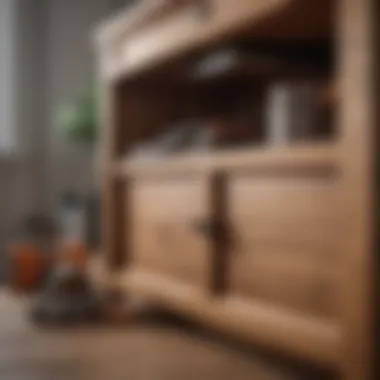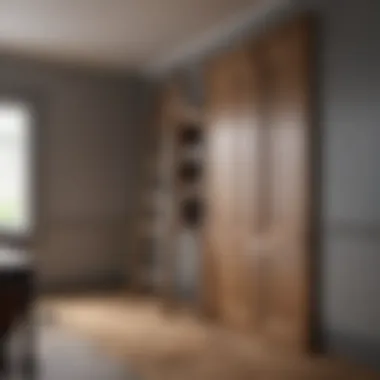Expert Tips for Safely Removing Cabinets from Walls


Intro
Removing cabinets from walls can seem like an overwhelming task. However, with the right preparation and knowledge, it can be accomplished without too much trouble. This guide aims to equip homeowners and DIY enthusiasts with the fundamental skills needed for successful cabinet removal. Understanding the steps involved, along with safety precautions and necessary tools, can make this process seamless.
In this article, we will delve into the various aspects of cabinet removal. We will discuss preparation, tools needed, safety tips, and detailed instructions. Furthermore, we’ll address potential obstacles that may arise during the process, so you can proceed with confidence.
By the end of this guide, you will not only be informed but also empowered to take on the project of removing cabinets from your walls.
Prelims to Cabinet Removal
Removing cabinets from walls is a task that many homeowners may face at some point. It is essential to approach this process with a clear understanding of its importance and implications. For some, it may stem from wanting to update the kitchen or bathroom for aesthetic reasons, while others may need to create additional space or access plumbing and electrical fixtures. Whatever the motivation might be, knowing how to effectively remove cabinets helps avoid damage to both the cabinetry and the wall structure itself.
The benefits of mastering cabinet removal extend beyond simple aesthetics.
- Efficiency in Space Management: Removing old cabinets can significantly improve the usability of a space.
- Cost-Effective Renovations: Rather than hiring professionals for every project, homeowners can save money by doing the work themselves.
- Personalization: It allows individuals to create a kitchen or workspace that suits their needs and style.
Before diving into the actual removal process, it is crucial to consider safety aspects and the right tools necessary. Assessing the cabinet's structure is also important to ensure that the task can be completed without unnecessary complications.
Understanding the why behind cabinet removal sets the stage for a successful remodel. It can influence choices in design and layout, ensuring that the final result adheres to the homeowner’s vision and practical requirements.
Tools and Materials Needed
Removing cabinets from walls requires careful planning and the right set of tools and materials. Understanding what you need is key to executing the project smoothly. Without the appropriate equipment, the task can become cumbersome and potentially dangerous. The right tools ensure not only efficiency but also safety during the removal process.
Essential Tools
Drill
A drill is an indispensable tool for the removal process. It allows for quick and efficient removal of screws or fasteners that may be holding the cabinet in place. A power drill, specifically, offers the ability to change torque settings, which can be beneficial when dealing with stubborn screws. Many advanced models come with features like variable speeds, making them versatile for different materials. However, care must be taken to select the right drill bit for the job; using the wrong size can lead to stripping the screw head.
Screwdriver
The screwdriver is a classic hand tool that is crucial for cabinet removal. It is effective for both loosening and tightening screws without the risk of damaging surrounding surfaces. A flathead or Phillips screwdriver will often suffice, depending on the type of screws used in your cabinets. The main benefit of using hand tools like a screwdriver is the control it gives you. However, the task may take longer compared to using a power drill, especially for many screws.
Stud Finder
Using a stud finder can significantly enhance the safety and success of cabinet removal. This tool detects framing studs behind the drywall. Knowing where these studs are can prevent damage to the wall and help avoid cutting into electrical wires or plumbing. A quality stud finder features both magnetic and electronic detection modes, which provides flexibility. Still, it is important to remember that not all models are equally reliable, and misreads can occur occasionally.
Level
A level is useful for ensuring that your cabinets are installed properly and that any new cabinets will be aligned correctly. A spirit level can help you identify any tilt in your existing cabinets before removal, which can indicate the need for adjustment in your wall or new cabinetry. The key characteristic of this tool is its simplicity; it is straightforward to use. However, for those unfamiliar with reading a level, misinterpretation can lead to visual misalignment in new installations.
Safety Equipment
Safety Glasses
Safety glasses are a basic but crucial part of your safety gear. They protect your eyes from dust and debris generated during the cabinet removal process. Clear lenses ensure a good view while working. Most models are designed to fit comfortably over regular glasses if needed. However, they can fog up if worn for extended periods in humid conditions, which may be an inconvenience.


Gloves
Wearing gloves is essential for protecting your hands during the removal of cabinets. Sturdy work gloves not only safeguard against sharp edges but also provide a better grip on tools and materials. When selecting gloves, look for those made from durable materials. While some gloves offer flexibility, others prioritize thickness for protection, so it's important to choose based on your specific needs.
Mask
A mask helps to prevent inhalation of dust and particles when removing cabinets, especially if the walls are older and may have lead paint or mold. A basic dust mask can help to filter out larger particles, but specialized masks with filters provide greater protection. Weighing comfort against protection is key, as a poorly fitting mask can make breathing difficult and become a distraction while working.
Additional Materials
Drop Cloths
Drop cloths are invaluable when it comes to protecting your flooring and nearby furniture from dust, debris, and paint smudges during cabinet removal. They are available in various sizes and materials, and their versatility makes them a great choice for many projects. A heavy-duty drop cloth provides better protection and can be reused for multiple tasks. However, lightweight options are easier to manage and store but may not offer the same durability.
Painter's Tape
Using painter's tape can assist you in creating clean lines when marking or preparing areas around the cabinets. It is easy to apply and remove without damaging the underlying surfaces. This feature makes it a beneficial tool when needing to protect areas from paint or to mark measurements related to the cabinets. One disadvantage is that it may peel paint if left for too long, so timing must be considered.
Paint or Wall Repair Materials
After removing cabinets, you might need to repair any wall damage or uneven surfaces. Having paint and wall repair materials on hand ensures you can address any issues promptly. Quality repair compounds can fill in holes and cracks effectively. It’s advisable to select paint that matches the existing wall color to maintain aesthetics. However, purchasing high-quality materials can be more expensive, so weighing your options is necessary.
Safety Considerations
When undertaking the task of removing cabinets from walls, the importance of safety cannot be overstated. This phase of the project serves as a foundation for not only avoiding injuries but also protecting the integrity of your home. By addressing safety considerations, you prepare yourself to navigate the complexities of this task with a calculated approach.
Assessing Load-Bearing Walls
Before commencing any demolition work, it is critical to determine whether the wall you are working on is a load-bearing wall. These walls support the weight of the structure above and require special attention during any alteration. Failing to recognize a load-bearing wall can lead to serious structural issues, such as sagging ceilings or even collapse. To assess if a wall is load-bearing, look at the blueprints of your home or consult a structural engineer. As a rule of thumb, walls that run perpendicular to the floor joists are typically load-bearing, while those that run parallel are more likely to be non-load-bearing.
Disconnecting Electrical Fixtures
Safety extends to ensuring that no electrical hazards arise during cabinet removal. If the cabinets potentially conceal electrical fixtures, the first step is to turn off the power running to those circuits. Locate the appropriate circuit breaker in your electrical panel and switch it off. Use a voltage tester to verify that the wires are off before touching them. Disconnecting any light switches or outlets linked to the cabinets will prevent electrical shocks and make the removal process safer.
Avoiding Water Pipes and Ducts
Another essential consideration is the presence of water pipes and ducts behind or within the cabinets. Damaging these systems can lead to extensive water damage or a breakdown of your heating and cooling systems. Before removal, use a stud finder to locate any plumbing or ductwork behind the wall. It is beneficial to have knowledge of your plumbing layout. If you're uncertain, consult with a professional plumber. Knowing where these utilities run will guide your actions and help you avoid costly mistakes.
Being prudent about safety considerations when removing cabinets not only reduces the risk of personal injury but also prevents significant damage to one's home and its systems.
Preparation Steps
Proper preparation is crucial when removing cabinets from walls. Not only does it set the stage for a smoother removal process, but it also minimizes potential damage to both the cabinets and the wall surface. By taking time to prepare, homeowners can avoid complications that may arise during the actual removal. This section delves into several key elements of preparation that will ensure your cabinet-removal project goes as efficiently as possible.
Clearing the Area
Before beginning the removal of cabinets, it is wise to start by clearing the area around the cabinets. This involves moving furniture, appliances, and any items that might obstruct your access to the cabinets. By creating ample workspace, you are more likely to operate without hindrance. It also helps in preventing any accidental damage to your possessions during the removal process.
Maintaining a clear area allows for better visibility and easier movement while handling tools. Using drop cloths to cover the floor can protect against scratches and spills, which is an added benefit to clearing the workspace. It is a simple but effective step that enhances overall safety.


Preparing the Cabinets
Next, focus on preparing the cabinets themselves for removal. This involves removing any items from inside the cabinets, including dishes and other stored goods. Having a clutter-free cabinet ensures that there are no surprises when you begin the detaching process. It also prevents injury from falling objects.
Furthermore, assess the condition of the cabinets before detaching them. Check for any loose fixtures or parts that may need tightening. It may also be a good idea to remove any shelves or additional components within the cabinets. This attention to detail can prevent unnecessary complications during the removal.
Marking for Reference
Finally, marking for reference is an essential step in your preparation. Use painter's tape or a pencil to mark the positions of screws, hinges, or any specific placements. These marks can guide you during the removal process, ensuring that you replace any further fixtures or re-install new cabinets in the same position.
Utilizing a level can also help you ensure that your marked lines are straight and even. This small step can go a long way in achieving a professional finish later on. It’s a simple tactic that keeps your project organized and ensures successful reinstallation of new cabinetry if that is the end goal.
Taking time to prepare not only enhances safety but also leads to a more successful cabinet removal process.
Altogether, these preparation steps set a firm foundation for the tasks ahead. By clearing the area, preparing the cabinets, and marking for reference, the subsequent steps in removing cabinets from walls will be much more straightforward. This foresight ultimately helps to mitigate frustration and enhances efficiency, allowing every individual involved to work with confidence.
Step-by-Step Removal Process
The removal of cabinets from walls requires a precise approach. A step-by-step removal process is essential in ensuring safety and efficiency. Through systematic procedures, individuals can avoid mishaps. This section outlines the critical steps, strategies, and benefits of a careful removal process. Following these methods minimizes the risk of damaging walls, cabinets, or personal injury. It is worthwhile for homeowners and enthusiasts to familiarize themselves with these steps.
Locating and Removing Fasteners
The first crucial step involves locating fasteners. Fasteners secure cabinets to walls. They may use various types, including screws, bolts, or brackets. Start by inspecting the cabinet's interior. Look for screws that may be hidden among the shelves. Use a stud finder to locate larger metal fasteners or brackets.
Once identified, select the appropriate tool. A screwdriver or drill can be useful. Ensure the chosen tool fits the fastener type. Removing fasteners is vital; it allows cabinets to become unattached from the wall. A few simple tips:
- Make a note of where each fastener is located to avoid losing them.
- Keep the area organized by placing removed fasteners in a container.
- Use a level to check alignment after fasteners are removed; a cabinet can shift slightly.
Detaching Cabinets from the Wall
After the fasteners have been removed, the next step is to detach the cabinets from the wall. Gently pull the bottom of the cabinet away from the wall. This will often be straightforward if all fasteners are taken out. If resistance is felt, check for any fasteners that may be overlooked.
Stand to the side of the cabinet. This positioning helps prevent any accidents should the cabinet fall. Ask for assistance from another person if the cabinets are large or heavy. Their help can provide stability and safety throughout this process. When lifting, focus on using your legs, keeping the back straight. Support the cabinet evenly and avoid jerky movements to prevent injury.
Handling Heavy Cabinets
Heavy cabinets can pose challenges. Weight management is essential for safety and efficiency during removal. Always assess the weight beforehand. If a cabinet is particularly heavy, don’t attempt to handle it alone. Here are some strategies:
- Break down the cabinet if possible, removing doors and shelves first. This reduces weight considerably.
- Use proper lifting techniques. Bend your knees and lift with your legs.
- Consider using moving straps or a dolly when walking a distance. Stability is key in preventing accidents.
Post-Removal Considerations
After successfully removing cabinets from your walls, the next important phase involves post-removal considerations. This stage ensures that the area is prepared for any further renovations, repairs, or new installations. Understanding what to look for and how to proceed can greatly influence the success of your project.
Inspecting Wall Conditions
Once the cabinets are off the wall, inspect the wall conditions thoroughly. Look for any signs of damage, such as missing paint, gouges, or exposed drywall. It is crucial to examine for moisture damage or mold, particularly if the cabinets were installed near sinks or water sources.
Using a stud finder can help identify any underlying issues behind the wall. If your drywall is damaged, it may need immediate attention. Additionally, check for uneven surfaces, which can affect future installations.


Repairing Wall Damage
Repairs to the wall should be your next step. Minor imperfections like small holes can often be patched with spackling compound. For larger areas of damage, you might require additional materials such as drywall sheets
- Gather the necessary materials:
- Follow these steps:
- Drywall sheets (for larger repairs)
- Spackling compound (for small holes)
- Sandpaper
- Paint and primer
- Apply spackling compound to cover small holes or gouges.
- For larger patches, cut out the damaged drywall area and replace it with a new piece. Secure it with screws, then compound over the seams.
- Once dried, sand down the repairs until smooth.
- Paint over the repaired area with primer and then a matching wall color.
Planning for New Installations
After ensuring the walls are in good condition, consider your plans for new cabinets or other installations. This might be an opportune moment to rethink the layout or design. Think about factors like:
- Functionality: What purpose will the new cabinets serve?
- Style: How will they fit with your overall interior theme?
- Space Optimization: Can you maximize the space differently than before?
Planning can involve measuring the area where new cabinets or shelves will go. Consider rearranging the available space to improve access or aesthetic appeal. Your wall’s condition can also dictate the type of installations. For instance, you might consider lighter materials or even floating shelves if the wall was compromised.
Remember, proper planning can save you time and ensure you get the most from your space.
In summary, post-removal considerations are essential for maintaining the integrity of your walls and for the success of future installations. Evaluate the walls thoroughly, address any issues promptly, and plan strategically to avoid complications down the road.
Potential Challenges
When undertaking the task of removing cabinets from walls, understanding the potential challenges that may arise is vital. This awareness helps you prepare more effectively and execute the removal smoothly. Various factors can complicate the process, including the types of fasteners used, the weight of the cabinets, and the condition of the wall behind the fixtures. Identifying these challenges in advance will allow for a more streamlined approach and may prevent unnecessary damage.
Dealing with Stubborn Fasteners
One of the most common hurdles is encountering stubborn fasteners that resist removal. These fasteners may have been secured tightly during installation or can become corroded over time. It is essential to identify the type of fastener before proceeding. If you find screws or bolts that do not budge, consider using penetrating oil to assist in loosening them. A proper drill attachment can also help. If the fasteners prove particularly stubborn, cutting them out might be necessary. In such cases, be careful to avoid damaging the cabinet or surrounding wall.
Managing Cabinet Weight
Cabinet weight is another challenge that can lead to complications during removal. Most cabinets can be heavy, especially when they are filled with items. If you are working alone, it is wise to assess your strength and stamina honestly. Consider recruiting someone to help support the cabinet's weight as you detach it from the wall. In addition, use proper lifting techniques to minimize the risk of injury. Strain can come from lifting awkwardly or trying to manage weight alone. So make sure to prioritize safety, securing cabinets adequately before moving them.
Addressing Wall Integrity Issues
Finally, wall integrity can be a significant concern. Over time, the wall structure may deteriorate, or previous installations may have compromised it. Inspect the wall for signs of damage or weakened spots before beginning the removal. If you notice issues, you may need to take more precautions to prevent further damage. It may also be worthwhile to contact a professional if the wall appears extensively compromised. Such matters can lead to larger renovation headaches if not handled correctly.
Proper preparation and awareness can prevent major issues when removing cabinets from walls. It pays to be diligent.
Epilogue
The conclusion serves as a pivotal section of this guide to removing cabinets from walls. It encapsulates the main concepts covered, reinforcing their relevance and importance to the readers. By summarizing the essential steps and safety precautions discussed, homeowners and DIY enthusiasts can gain a clearer understanding of the overall process.
Recap of Key Steps
During the cabinet removal process, several key actions should be highlighted. First, assessing the wall type and ensuring no electrical wires or plumbing is present is crucial. Following that, removing the contents of the cabinets and ensuring all tools are assembled aids in a smoother operation. When actual removal occurs, knowing where to locate fasteners and how to manage cabinet weight will prevent damage and injury. Finally, inspecting wall conditions post-removal ensures any necessary repairs are made before new installations.
Encouragement for DIY Enthusiasts
For those tackling this task, it is important to approach with confidence. Understanding the methods discussed fosters competence in executing renovations. Cabinet removal might seem daunting, but with careful preparation and adherence to outlined steps, successful results are achievable. DIY enthusiasts should remember that practice builds skills. Gaining hands-on experience not only enhances capability but also increases a sense of accomplishment. Every home improvement project provides valuable lessons.
"Success in DIY projects often lies in careful planning and execution."
By keeping these considerations in mind, newcomers to home improvement can effectively engage in cabinet removal jobs and enjoy the process.



